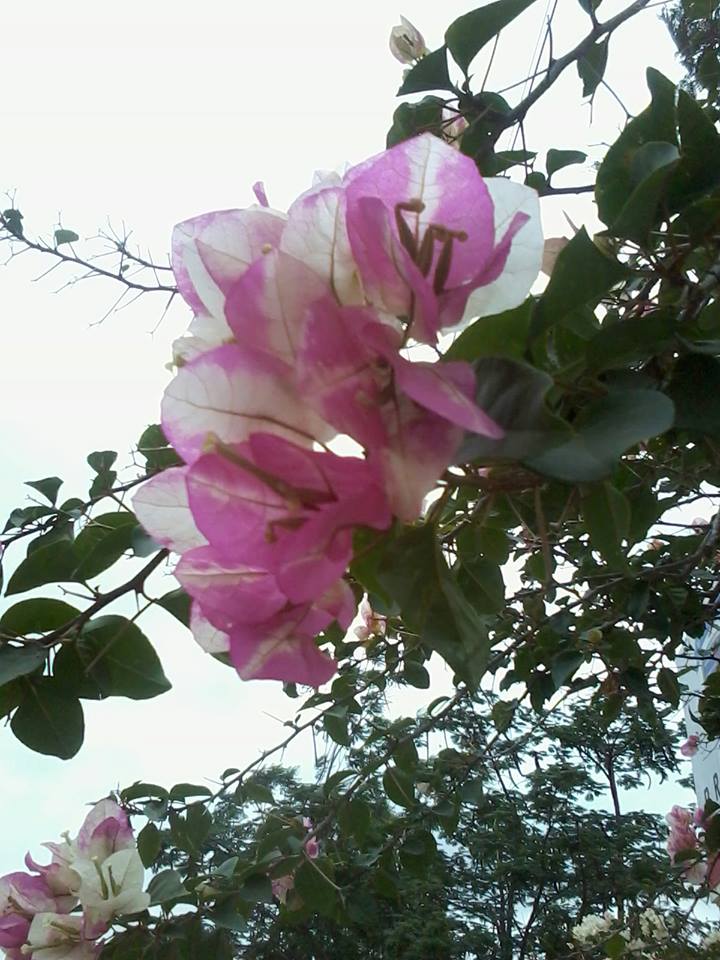It was a hectic morning as always. Driving for a full 10 minutes in rush hour Mumbai traffic and successfully crossing the grid-locked Khodadad circle, I was ascending the Tilak bridge at a crawl. Looking out of my window, I saw this beautiful and tall bougainvillea vine that had crawled on the top of a tall tree to cast its branches and dark red flowers over its ‘host’. In the middle of summer, this concentration of color was arresting enough to warrant a second and third look as I passed it, and its uncomplicated beauty was calming. Now when I pass it, I always look for this splash of red, and in turn it never fails to coax a smile from me.
My admiration of this vine has prompted a little research into its antecedents and some trivia connected to it. The Bougainvillea gets its quaint name from the French Navy admiral and explorer Louis Antoine de Bougainville. He was the head of a naval circumnavigation expedition, when this plant was discovered in the rain forests of the Amazon in the late eighteenth century. But lest one thinks that this navy man tramped through the forest to forage for this plant, one could not be more wrong. The actual discovery and drudge work was done by the botanist accompanying him on this voyage, Philibert Commercon. Some sources credit this discovery to his girl-friend, Jeanne Bare, who sneaked on board disguised as a man!. Maybe, the romance of having her on board sensitized Phil to this pretty flowering shrub in the midst of the jungle. Whatever the reason, the custom of the day dictated that the discovery had to be given the name of the patron of the expedition and so, Captain Bougainville was immortalized forever by this humble plant, while Phil had to settle for being mentioned in articles like this one.
Requiring very little water, this shrub was found to grow well and flower profusely in bright sunshine, even perennially at times. Over the next 100 years, this plant was sent far and wide by English and French nurseries, even to places as far as Australia and all the British colonies.
The blooms that I had admired so much are nothing but paper-like bracts; a trick of Mother Nature to ensure that that the REAL flower, a thin white slender thing in the center gets the attention of the bees and insects. Modern botanists have given these varieties rather exotic monikers such as ‘Juanita Hatten’ (dark pink), California Gold (dark yellow), Texas Dawn (small pink), Surprise (large pink-white bi-colored ) and Double Pink (pink colored -no surprise there). And so on.
Knowing how much I enjoy a moment of admiration for a pretty flower, I take a moment to stop in my tracks (gets me odd looks at times) to admire the beauty of the short-lived hibiscus flowers, high-maintenance roses or seasonal petunias in a potted plant in any balcony I pass. Sometimes grown in a rusty can or bucket, these add color to an otherwise drab building exterior.
But nothing is more unpretentiously pretty as bougainvillea vines flowering in a mix of whites, magentas, pinks and peaches by the side of the road, leaning over a compound wall or climbing artfully to the top of an archway and adding beauty to its surrounding, all day long. Unfussy, requiring little attention, needing little pesticides and growing with a little coaxing from fertilizers, they are grown in all likely (parks, gardens) and unlikely places (terraces of several corporate structures and high-rises). A blog I read, mentions how the writer stumbled across a young man reading love-poetry to his girl, in Hanging Garden, Mumbai. They had sheltered from the blazing noon sun under a prettily flowering bougainvillea. In the absence of roses and lilies, it is gratifying to note that this humble vine can inspire romance. In the middle of a busy intersection near Dadar railway station, in central Mumbai, is a bougainvillea with vivid magenta ‘flowers’. Surrounded by vendors and sellers of everything from plastic bottles and alarm-clocks, makers of duplicate keys to makers of hot jalebis, this tall vine growing independently in the shape of a canopy seems to embody the spirit of free enterprise around it.
Perhaps we all need to take a lesson from this humble vine, which having traveled the seven seas, has flourished in foreign climes and lends so much color and consequent energy to its surrounding, after getting so little from the people that it charms.
**This piece was earlier published in http://www.talkingcranes.com/
Ujwala Shenoy Karmarkar is a practicing Anaesthesiologist working in Mumbai. She loves conversations, meeting people, reading and listening to Hindi film songs. She writes about anything that moves her.







[…] http://unboxedwriters.com/2013/08/a-splash-of-joy/ – […]
Well written ujwala.